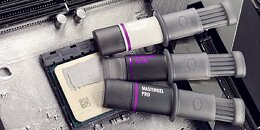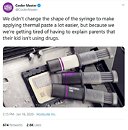Friday, January 17th 2020

Cooler Master Redesigns its TIM Packaging so Parents Don't Think Their Kids are Doing Drugs
Applying thermal interface material (TIM) properly is a simple task that is under-documented or sometimes even misrepresented by the press. A bad application harms, rather than help your thermals. Their application varies from either the "pea drop" method, where you squeeze the TIM syringe or sachet to put out a tiny pea size blob onto your chip, letting the pressure from the heatsink spread the TIM out; or using an included spatula or plastic card to spread the TIM out to a very thin film. Of course when minors have plastic cards and syringes lying around in their rooms, parents sometimes get the wrong idea.
Cooler Master, in a tweet confirmed that it redesigned its TIM packaging to address exactly this: that TIMs supplied in syringes that look and function identical to medical syringes, make parents think their kids are doing drugs. "We didn't change the shape of the syringe to make applying thermal paste a lot easier, but because we we're getting tired of having to explain parents that their kid isn't using drugs," reads the Cooler Master statement. The new packaging by Cooler Master looks closer to a highlighter or Play Doh tube than it does a medical syringe. It still uses a syringe-like manual piston to dispense TIM, but the nozzle is wide and flattened to put out a layer of TIM directly on your chip. It's no longer round, and you can no longer attach injection needles. This nozzle also takes away the need for plastic cards or spatulas. The design, however, has a downside: the "pea drop" application is impossible, and a somewhat sub-optimal method is being forced upon users. Did Cooler Master just give in to pressure from an uninformed section of the market? Could a printed disclaimer on a conventional round syringe have helped instead? Tell us in the comments below.
Cooler Master, in a tweet confirmed that it redesigned its TIM packaging to address exactly this: that TIMs supplied in syringes that look and function identical to medical syringes, make parents think their kids are doing drugs. "We didn't change the shape of the syringe to make applying thermal paste a lot easier, but because we we're getting tired of having to explain parents that their kid isn't using drugs," reads the Cooler Master statement. The new packaging by Cooler Master looks closer to a highlighter or Play Doh tube than it does a medical syringe. It still uses a syringe-like manual piston to dispense TIM, but the nozzle is wide and flattened to put out a layer of TIM directly on your chip. It's no longer round, and you can no longer attach injection needles. This nozzle also takes away the need for plastic cards or spatulas. The design, however, has a downside: the "pea drop" application is impossible, and a somewhat sub-optimal method is being forced upon users. Did Cooler Master just give in to pressure from an uninformed section of the market? Could a printed disclaimer on a conventional round syringe have helped instead? Tell us in the comments below.


66 Comments on Cooler Master Redesigns its TIM Packaging so Parents Don't Think Their Kids are Doing Drugs
Guess I was the trustworthy kind of son. :D
Again, just another solution to a problem caused by the same parents who just stick a tablet in front of their kids for the first 10 years of the kid's life.
Parents who are ignorant of their kid of getting mixed up in to some thing bad are normally the ones it happens too.
TPU appears to be the only outlet online that didn't treat this as the joke it very clearly is.
They go on to say "that would imply that the rest of their tweet is serious -- the bit about the new design making thermal paste easier to apply, to be specific. If the company does feel that way, we can point toward plenty of PC enthusiasts that might disagree."
Which only makes Techspot look like idiots, because Cooler Master's own website recommends spreading thermal paste manually on every single one of their thermal paste products. But even so, at least they opted to hedge their bets by suggesting perhaps it was a joke, despite the fact they didn't do their due diligence by, you know, actually checking.
I really don't know why the tech press and enthusiasts are so in love with this ridiculous "pea method is best" thing. It's not as if even the manufacturers agree on this completely, but it did pique my curiosity to see how much they disagree, so you know what? I did some digging. Through the magic of *basic google searching* I have found a great deal of relevant information.
1 - Marketing Mentions specifically "Thanks to its excellent spreading properties, there is no need to manually spread NT-H2 before installing the cooler", implying Noctua believes thicker compounds should be spread manually.
2 - Intel's instructions are to use substantially more compound than most enthusiasts, specifying the entire "pillow pack" be used. This is presumably to ensure adequate spread in single-application environments where cleanup is not a concern)
3 - EK Specifically mentions that their other recommended thermal paste, TG Hydronaut, requires a manual spread due to it's "higher density". Since EK Hydronaut is actually less dense than EK Ectotherm, I presume this to be an error and Viscosity is meant here.
4 - Note that the cheaper product does not include an applicator - Corsair's paste has been poorly reviewed and is known to be a rebranded bulk compound with unimpressive specs, so I contend that this product's application method is determined by price, not performance
As you can see, "Thin Spread" is by far the most commonly recommended application method, being recommended by manufacturers for 37 products out of 53 (38 if including Conductonaut) whereas dot method is recommended by only 8 manufacturers outright, two of whom recommend both methods for different products. Two manufacturers specifically mention that the viscosity of their paste makes manual spreading unnecessary, alluding to it being necessary for other pastes of different viscosity.
Disclaimer - I put anything that included an applicator down as a "Thin Spread", because otherwise said applicators were being included without the intent of their being used. No manufacturer's actual install instructions actually contradicted this, as most manufacturers including applicators either specify a spread explicitly, or provide no instructions for install and presume the user knows what to do with an applicator.
Also note Arctic Silver's unique "tinting" method, which is both a spread *and* a vertical line method, fitting neither commonly recommended application method perfectly. If this is considered a spread method then 40 products of 53 come with a recommendation to spread the paste, not dot method.
To detour from this however, and to get back to the point of the thread, which is "Did btarunr miss Cooler Master's sarcasm" - I present this, from CM's own product information PDF:
Something tells me that CM's social media isn't exactly given carte blanche to directly contradict their product pages, so perhaps we should assume they weren't doing so?
I usually using single drop or dabs paste
This design make it harder for applying that methodWait, crayon and vegetable oil works well as thermal paste?
But of course, while you're mocking people for not understanding thermal paste, I imagine you're far too busy to read the thread you're responding to, right?